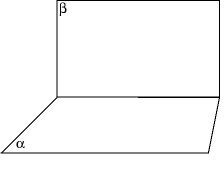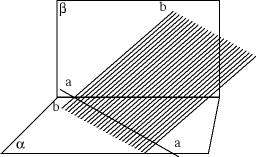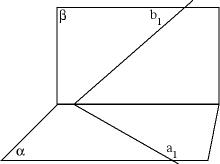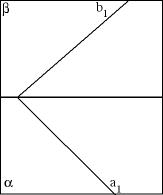Descriptive Geometry
home | courses | topics | theorems | starters | worksheets | timeline | KS3 | KS4 | KS5
Descriptive Geometry was discovered by Gaspard Monge, a French mathematician. He developed this technique, versions of which were known to stone-masons centuries before Monge.
Descriptive Geometry is a graphical communication system, concerned with describing space in a mathematical way, so that the geometrical objects and their interaction can be imagined and drawn.
This is how it works:
- Imagine a point in space: point has no breadth, length or width, it is without dimensions. (To make it simpler to understand, the point in the drawing below obviously has some dimensions.) Imagine that this point starts moving slowly.

- Imagine now this point to move very fast in one direction only. As you see it move in your mind, it will leave a trace: this trace will be a straight line.

- Now imagine this straight line is stationary for a moment. You would like it to move like the point moved, but you need a direction. Another straight line will cross over this line, which we will call a. The line which gives direction will be called b.

- This movement again leaves a trace. In this case the trace is a plane.
You may need to describe or investigate this plane further. This will probably happen when you have a plane which intersects with other planes to perhaps make some object.
In this case you will need to have some kind of coordinate system. Descartes invented a coordinate system long before Monge thought of his Descriptive Geometry.
Because you are working on the plane, you want to put it into a 3-d coordinate system to describe it as fully as possible (if you had a line, you would probably be happy to describe it in a 2-d coordinate system).
So you have two planes as your coordinate system: one is called Alpha, the other Beta.

Put your plane aabb into this coordinate system.

Some of the lines of our plane aabb will also lie in the planes of the coordinate system. Let us call them a 1 a 1 and b 1 b 1.

These two lines are called the traces of plane aabb (traces which the plane left on the coordinate system). You can now 'drop' the horizontal projective plane Alpha so that it comes 'under' vertical plane Beta.

Monge described two intersecting planes with the following diagram:

Look at Monge's diagram. Can you work out what how many planes intersect there? What is the label of the line that describes their intersection?
Monge used the system to describe any geometrical figure or solid. The beauty of the system is in the process of imagining the properties of solids through their generation - how they are made through the movement of points, lines, and planes - and how they leave traces behind them.
Gaspard Monge discovered Descriptive Geometry in the mid 1760s. Click on his portrait above to find more about this famous mathematician.
He is considered one of the savants of the French nation. His body is burried in a tomb in Pantheon - see it here.
He taught at Ecole Normale and Ecole Polytechnique in Paris.
Monge spent some time in Egypt - see some famous mathematicians that all lived in Alexandria centuries before Monge visited it... click here.
artefacts | numerals | concepts | people | places | pythagoreans | egyptians | babylonians
_____________________________________________________________________________________________________________________
Acknowledgements | Copyright | Contact | Mission Statement | Tell a friend about this site
